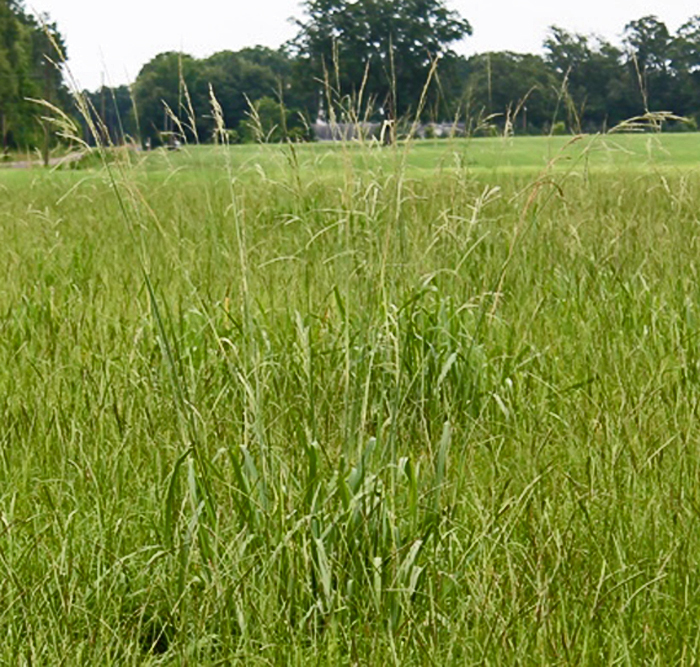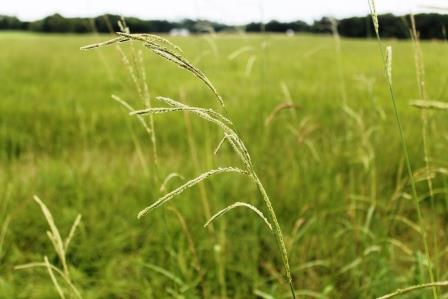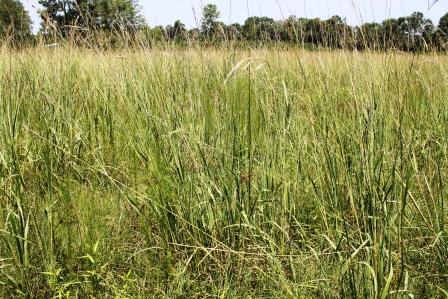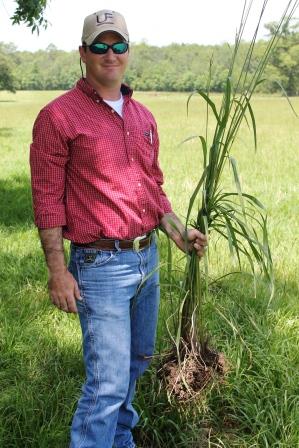
Vaseygrass in a Bermuda/Bahia hay field. This hard to control weed has become a common sight recently. Photo Credit: Mark Mauldin
You may have noticed vaseygrass, with its conspicuously tall seed heads, in pastures and hayfields where you have not noticed it before. Most of the factors explaining the increased occurrence of vaseygrass this summer relate to the relatively wet conditions we’ve had here in the Panhandle for the past year or so.
1) Vaseygrass likes moist soil. Only under relatively moist conditions can Vaseygrass out-compete our improved perennial pasture grasses.
2) Vaseygrass spreads by seeds; moist conditions allow a higher percentage of seeds to successfully germinate.
3) The wet conditions last summer reduced the number of times many hayfields were cut, allowing any preexisting plants to successfully set and spread seed.
What to do about vaseygrass? Vaseygrass is a weed; it has a much lower nutritional value than our improved pasture and hay grasses. Cattle will graze it when it is immature, but they tend to avoid it as it matures. In a hay field, it lowers the overall quality of the hay produced and can present curing challenges. In addition to these concerns, vaseygrass has the ability to spread very fast. In short, vaseygrass should be controlled, not ignored. As with most weeds, small infestations are much easier to handle than large ones – so control your little bit of vaseygrass now before you have a whole field full to deal with.
Small infestations can be effectively controlled by spot spraying with a 1% glyphosate solution (1.2oz/gal) or hand pulling. Be careful when using glyphosate, it will severely injure desirable grass species. Hand pulling is a fairly realistic option with Vaseygrass because it is a true bunch grass with virtually no rhizomes and a fairly small root system. To help reduce the spread and persistence of vaseygrass it is best to spot spray or hand pull before seeds drop. Unfortunately, even if you control vaseygrass before it drops seeds, chances are you will have some plants that will need to be controlled the following year as well.
If the situation warrants chemical control over the entire field there are very few options available, especially during the growing season. In bermudagrass Impose can be used. At 6-8oz/ac this product will control vaseygrass but it will also cause significant damage to bermudagrass. One cutting of hay will effectively be lost due to the damage from Impose. Timing is crucial when using Impose, for additional information consult with your County Extension Agent. There are no selective herbicide options for controlling vaseygrass in bahiagrass; a wiper application of glyphosate (above the bahiagrass) is about the only option while the bahia is actively growing. Control of vaseygrass and other grass weeds is often easier to achieve when the field is dormant. Even with that in mind, attempting control now is worthwhile because, left unchecked, the infestation will only get worse.

Vaseygrass seedhead – seedhead structure can help distinguish vaseygrass from other grass weeds.
Photo Credit: Mark Mauldin
A few other things to consider:
1) There are other, similar looking, grass weeds that are easier to control than vaseygrass. Before you begin treatment, be certain you know what you are trying to control.
2) Weed control is more effective when proper soil fertility is maintained; desired species are more competitive and fill voids left by controlled weeds faster.
3) Mowing, especially with a rotary mower, after seeds are present can potentially make the problem worse by scattering the seeds.
If you have recently discovered vaseygrass on your farm, do what you can now to prevent it from spreading. If you have an established population, achieving control will be more difficult but worthwhile in the long run.
Herbicide information in this document courtesy of 2014 Weed Management in Pastures and Rangeland and Dr. Jay Ferrell, UF/IFAS Extension Weed Specialist.


